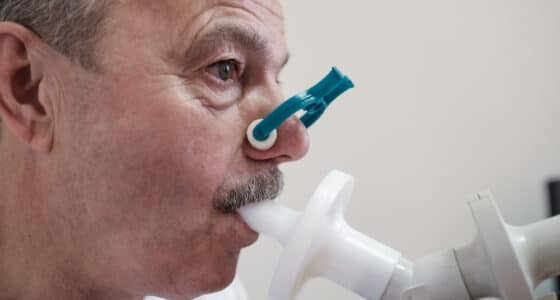In searching for better outcomes for patients with malignant pleural mesothelioma and asbestos-related lung cancer, achieving earlier diagnosis is a top priority that would facilitate faster and more effective treatment. Two papers published by researchers from a laboratory at the Hackensack Meridian Center for Discovery and Innovation (CDI) may signal a real breakthrough in achieving that goal.

Exhaled Breath Test May Detect Mesothelioma and Lung Diseases Faster
The research that is exciting mesothelioma physicians comes from CDI Associate Member Olivier Loudig, Ph.D., and his colleagues, who report that they’ve successfully collected, separated, and profiled lung biomarkers from human breath so that a non-invasive approach to diagnosis can be used. The next step is identifying biomarkers for specific human lung diseases.
Dr. Loudig’s laboratory at the CDI focuses on capturing and identifying nanoparticles known as extracellular vesicles (EVs) that are released by almost all cells, and which are released in greater numbers by cancer cells, including mesothelioma cells. His group developed a technology called EV-CATCHER to isolate these EVS and use sequencing profiles of small RNAS to identify tumors non-invasively.
Next Step in Technology is Identifying Cancer Cells in Human Exhaled Breath
For people exposed to asbestos, the idea of being able to submit exhaled breath samples to detect mesothelioma or asbestos-related lung cancer represents a significant improvement over the current invasive technologies that can only be used after symptoms develop. Dr. Loudig is currently working on purifying EVs so that specific disease markers can be identified, an approach that would significantly advance screening, diagnosis, and treatment.
Writing of their findings in the Journal of Extracellular Vesicles, Dr. Loudig’s team wrote, “Our analyses confirm the utility of our customizable EV-CATCHER assay for the selective purification of exhaled EVs harboring surface proteins of terminal bronchiole and alveoli lung tissue origin from [exhaled breath condensate…. We envision that expanding our approach to studying human primary and other secondary lung cancers … has the potential to identify relevant exhaled human EV biomarkers.”
If you or someone you love is at risk for an asbestos-related disease, this research offers significant hope. For more information on the resources available to you, contact the Patient Advocates at Mesothelioma.net today at 1-800-692-8608.
